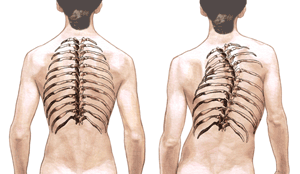Everyone’s spine has curves. These curves produce the normal rounding of the shoulder and the sway of the lower back. A spine with scoliosis has abnormal curves with a rotational deformity. This means that the spine turns on its axis like a corkscrew. Scoliosis is a curvature of the spine which may have its onset in infancy but is most frequently discovered in adolescence. It is more common in females by a 2:1 ratio. However, when curves in excess of 30 degrees are evaluated, females are more frequently affected by a ratio of approximately 10:1. The cause of the most common form of scoliosis; idiopathic scoliosis, is unknown, but there have been hereditary factors discovered that are present.
Scoliosis causes shoulder, trunk and waistline “asymmetry”. In mild forms, the condition may be barely noticed; however, in severe  forms there is significant disfigurement, back pain and postural fatigue, and it may be associated with heart failure. Fortunately the majority of scoliosis cases need only close follow-up to watch for worsening of the curve. Some cases require more aggressive treatment which could include surgery. The non-operative treatment of scoliosis involves observing the deformity with examinations and repeated x-rays. Under certain circumstances, when spinal growth remains, a brace may be used in combination with follow-up x-rays. Physical therapy exercises have not been shown to be effective treatment for scoliosis. The most common surgical treatment for scoliosis is a spine fusion using special stainless steel rods, hooks, and a bone graft. The rods are attached to the spine with hooks and the curved portion of the spine is carefully straightened. Then, small strips of bone graft are placed over the spine to fuse it in a straight position. As the bone graft heals over the next several months, the spine becomes solid and will not curve again. But the part of the spine that has not been fused will still be flexible, and allow nearly normal overall movement.
forms there is significant disfigurement, back pain and postural fatigue, and it may be associated with heart failure. Fortunately the majority of scoliosis cases need only close follow-up to watch for worsening of the curve. Some cases require more aggressive treatment which could include surgery. The non-operative treatment of scoliosis involves observing the deformity with examinations and repeated x-rays. Under certain circumstances, when spinal growth remains, a brace may be used in combination with follow-up x-rays. Physical therapy exercises have not been shown to be effective treatment for scoliosis. The most common surgical treatment for scoliosis is a spine fusion using special stainless steel rods, hooks, and a bone graft. The rods are attached to the spine with hooks and the curved portion of the spine is carefully straightened. Then, small strips of bone graft are placed over the spine to fuse it in a straight position. As the bone graft heals over the next several months, the spine becomes solid and will not curve again. But the part of the spine that has not been fused will still be flexible, and allow nearly normal overall movement.
